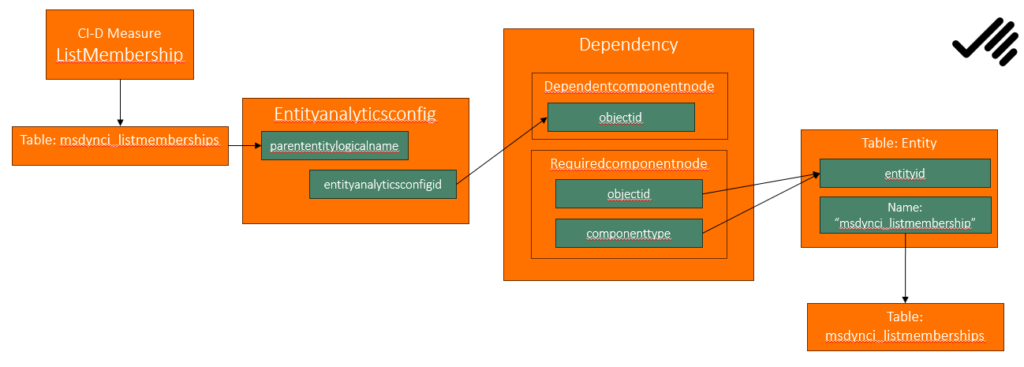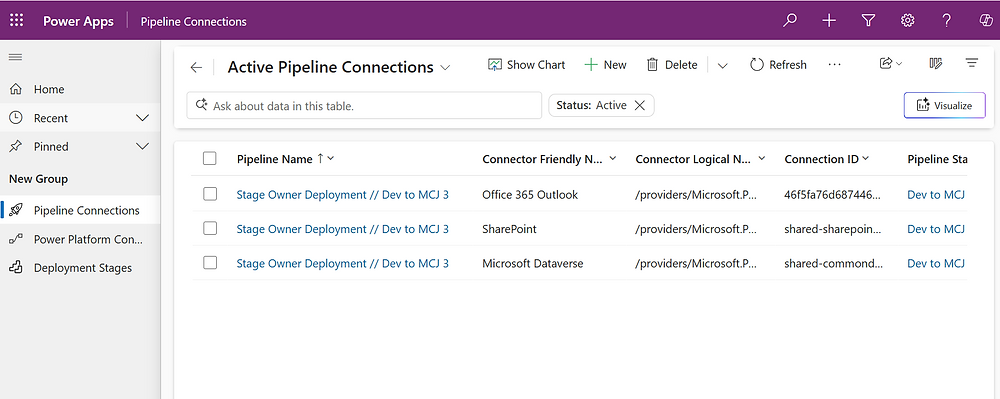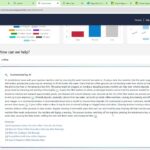Now Reading: CI-D Measure dependency on Dataverse
-
01
CI-D Measure dependency on Dataverse
CI-D Measure dependency on Dataverse

When measures are created in CI-D to be used in CI-J there are dependencies created which will stop you from removing the measure. CI-D is not very helpful in telling you how to remove it. I will try to be a bit more helpful.
When trying to remove the Measure this is the error I got:
Error: Detected DataVerse dependencies in Measure: ListMemberships. Please delete these dependencies and merge again.
Request ID: 14056846-b9c1-4ec8-98c2-88778e518b88
Time: 2024-12-05, 11:12:10My investigation below with the help of Microsoft Support lead me to the understanding according to the image above. As you can see dependency is actually sort of circular, or at least one part of the dependency (dependent component) is at the entityanalytics on the record which points to msdynci_listmemberships, on the other hand (required component) on the table msdynci_listmemberships.
The fix, is to remove the record in entityanalytics. Easiest way in this case, is to just use a browser console where you are logged into the right Dynamics.
To remove the entityanalytics record that is blocking this:
Xrm.WebApi.deleteRecord('entityanalyticsconfig', 'fc105928-3170-ef11-a671-000d3a64e5b5')
After this I was able to remove the measure in CI-D.
Below I will detail the steps I did to understand this.
The first step is to look in the table “entityanalyticsconfig” searching for the name of the Measure. Its name is “msdynci_” + name of the measure. Check out the metadata if you are unsure.
<fetch top="50">
<entity name="entityanalyticsconfig">
<filter>
<condition attribute="parententitylogicalname" operator="eq" value="msdynci_listmemberships" />
</filter>
</entity>
</fetch>{
"value": [
{
"isenabledforadls": true,
"parententityid": "dd7613fe-806e-ef11-a670-000d3ad82e35",
"modifiedon": "2024-09-11T11:29:54Z",
"componentidunique": "807e7e6d-71f5-446a-8009-437cbf5a922a",
"isenabledfortimeseries": false,
"versionnumber": 15487568487,
"parententitylogicalname": "msdynci_listmemberships",
"entityanalyticsconfigid": "fc105928-3170-ef11-a671-000d3a64e5b5",
"componentstate": 0,
"organizationid": "ba0a9fa5-462b-45cc-b603-e9b16acd63c4",
"solutionid": "fd140aae-4df4-11dd-bd17-0019b9312238"
}
]
}As you can see above the id is fc105928-3170-ef11-a671-000d3a64e5b5. This is the record I did the removal on above.
To further understand the dependency record for this, let’s dig into that table, searching for a record with this id.
<fetch top="50">
<entity name="dependency">
<attribute name="dependencyid" />
<attribute name="dependencytype" />
<filter>
<condition entityname="dcn" attribute="objectid" operator="eq" value="fc105928-3170-ef11-a671-000d3a64e5b5" />
</filter>
<link-entity name="dependencynode" from="dependencynodeid" to="dependentcomponentnodeid" link-type="inner" alias="dcn">
<attribute name="componenttype" />
<attribute name="objectid" />
<attribute name="parentid" />
</link-entity>
<link-entity name="dependencynode" from="dependencynodeid" to="requiredcomponentnodeid" link-type="inner" alias="rcn">
<attribute name="componenttype" />
<attribute name="objectid" />
<attribute name="parentid" />
</link-entity>
</entity>
</fetch>{
"value": [
{
"rcn.componenttype": 1,
"rcn.parentid": "00000000-0000-0000-0000-000000000000",
"dcn.parentid": "00000000-0000-0000-0000-000000000000",
"dcn.objectid": "fc105928-3170-ef11-a671-000d3a64e5b5",
"dependencyid": "e46e52db-46a7-4585-8a6a-6ba888a5bd1f",
"dcn.componenttype": 430,
"rcn.objectid": "dd7613fe-806e-ef11-a670-000d3ad82e35",
"dependencytype": 2
}
]
}The result shows us that the required component id is: dd7613fe-806e-ef11-a670-000d3ad82e35 which is of type: 1.
By checking this table in Microsoft Learn, we can see what this is: (both link and table)
By searching the table called “entity” for 430, we can find what table this represents:
| Values | Label |
|---|---|
| 1 | Entity |
| 2 | Attribute |
| 3 | Relationship |
| 4 | Attribute Picklist Value |
| 5 | Attribute Lookup Value |
| 6 | View Attribute |
| 7 | Localized Label |
| 8 | Relationship Extra Condition |
| 9 | Option Set |
| 10 | Entity Relationship |
| 11 | Entity Relationship Role |
| 12 | Entity Relationship Relationships |
| 13 | Managed Property |
| 14 | Entity Key |
| 16 | Privilege |
| 17 | PrivilegeObjectTypeCode |
| 20 | Role |
| 21 | Role Privilege |
| 22 | Display String |
| 23 | Display String Map |
| 24 | Form |
| 25 | Organization |
| 26 | Saved Query |
| 29 | Workflow |
| 31 | Report |
| 32 | Report Entity |
| 33 | Report Category |
| 34 | Report Visibility |
| 35 | Attachment |
| 36 | Email Template |
| 37 | Contract Template |
| 38 | KB Article Template |
| 39 | Mail Merge Template |
| 44 | Duplicate Rule |
| 45 | Duplicate Rule Condition |
| 46 | Entity Map |
| 47 | Attribute Map |
| 48 | Ribbon Command |
| 49 | Ribbon Context Group |
| 50 | Ribbon Customization |
| 52 | Ribbon Rule |
| 53 | Ribbon Tab To Command Map |
| 55 | Ribbon Diff |
| 59 | Saved Query Visualization |
| 60 | System Form |
| 61 | Web Resource |
| 62 | Site Map |
| 63 | Connection Role |
| 64 | Complex Control |
| 70 | Field Security Profile |
| 71 | Field Permission |
| 90 | Plugin Type |
| 91 | Plugin Assembly |
| 92 | SDK Message Processing Step |
| 93 | SDK Message Processing Step Image |
| 95 | Service Endpoint |
| 150 | Routing Rule |
| 151 | Routing Rule Item |
| 152 | SLA |
| 153 | SLA Item |
| 154 | Convert Rule |
| 155 | Convert Rule Item |
| 65 | Hierarchy Rule |
| 161 | Mobile Offline Profile |
| 162 | Mobile Offline Profile Item |
| 165 | Similarity Rule |
| 66 | Custom Control |
| 68 | Custom Control Default Config |
| 166 | Data Source Mapping |
| 201 | SDKMessage |
| 202 | SDKMessageFilter |
| 203 | SdkMessagePair |
| 204 | SdkMessageRequest |
| 205 | SdkMessageRequestField |
| 206 | SdkMessageResponse |
| 207 | SdkMessageResponseField |
| 210 | WebWizard |
| 18 | Index |
| 208 | Import Map |
| 300 | Canvas App |
| 371 | Connector |
| 372 | Connector |
| 380 | Environment Variable Definition |
| 381 | Environment Variable Value |
| 400 | AI Project Type |
| 401 | AI Project |
| 402 | AI Configuration |
| 430 | Entity Analytics Configuration |
| 431 | Attribute Image Configuration |
| 432 | Entity Image Configuration |
<fetch top="50">
<entity name="entity">
<attribute name="logicalname" />
<filter>
<condition attribute="entityid" operator="eq" value="dd7613fe-806e-ef11-a670-000d3ad82e35" />
</filter>
</entity>
</fetch>{
"value": [
{
"logicalname": "msdynci_listmemberships",
"entityid": "dd7613fe-806e-ef11-a670-000d3ad82e35"
}
]
}Hence, from this I generated the image above. Since it is something of a circular reference, Microsoft Support suggested that I remove the entity analytics record with id: e46e52db-46a7-4585-8a6a-6ba888a5bd1f. However, not entirely sure what this is and hence I tried the one I had gotten in the first steps above, and that worked.
Generally I think it is a good idea to investigate what the dependencies point to, before removing something. In this case the dependency record in itself wasn’t removed, only the dependent part.
Thanks to Microsoft support for helping out with this and I hope it might shed some insights if you are having similar issues. I also think breaking down the dependency table in a tool in for instance XrmToolBox would be a great idea. I have a bit of a bad conscience for BulkDeleteManager that I own and I am not giving enough love, so feel free to build it based on this and I guess some more stuff. I will be happy to help out the the investigations if you are willing to build it.
Original Post https://powerplatform.se/ci-d-measure-dependency-on-dataverse/















